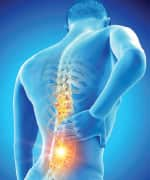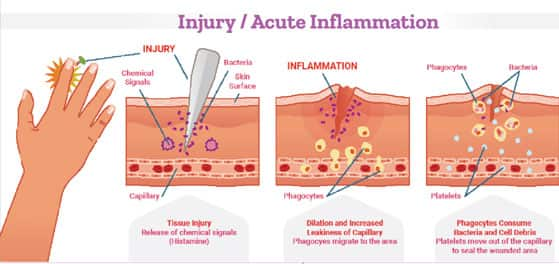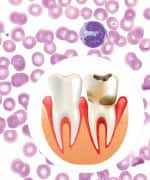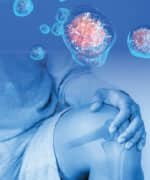Life Extension Magazine®
Acute inflammation is an important part of the body’s response to injury or infection. But when that inflammation does not resolve and becomes chronic, it causes major problems.

Chronic inflammation contributes to accelerated aging and almost all forms of persistent age-related disorders, including cancer, cardiovascular disease, and dementia.1,2
Many compounds can reduce and lower the fires of inflammation. But scientists have discovered a group of unique compounds produced in the body that are required for the resolution of inflammation.
These compounds, called pro-resolving mediators or PRMs, can help return inflamed tissues back to their healthy state, resolving inflammation and its harmful long-term effects.
PRMs are a family of naturally occurring lipid mediators, sometimes also referred to as Specialized Pro-resolving Mediators (SPMs).
A recent article in the journal BioFactors examined the scientific and medical literature on PRMs, including evidence that they may help fight infection.3
Inflammation and Resolution

Acute inflammation is the body’s immune response to an immediate threat or injury, including tissue damage, irritation, toxins, and infections.
“First responder” immune cells enter the affected area from the bloodstream, working to eliminate the threat and defend the body from further harm.
After that, the inflammation should resolve.
However, inflammation does not always stop on its own. Instead, it can enter a longstanding “limbo” state and become chronic inflammation, doing damage for months or years to come.
This chronic inflammation underlies many diseases, such as diabetes, heart disease, cancer, and overall aging.4,5 Reducing inflammation throughout the body is helpful but not enough to completely restore health. Inflammation needs to be resolved.
Resolution of inflammation is a complex, active process guided by specific signaling compounds produced in the body.6,7 Among these compounds are pro-resolving mediators (PRMs).
PRMs are different from anti-inflammatories. They do not simply reduce inflammation—they begin and guide the resolution of inflammation. They play an important role in getting tissues back to their healthy, functional state.8
Without adequate PRMs, inflammation can persist and do great harm.9,10
Types of PRMs
For years, it has been known that omega-3 fatty acids found in fish oil have anti-inflammatory properties, but it was not fully understood why.
As it turns out, PRMs are fat- or lipid-based compounds. They are produced from oily substances, including the omega-3 fatty acids found in fish oils (such as DHA and EPA).
Adequate intake of these omega-3s is required for the production of adequate levels of PRMs in the body.
There are a number of different PRMs produced in the body:3,8
- E-series resolvins are produced from EPA.
- D-series resolvins, protectins, and maresins are all produced from DHA.
- Lipoxins are synthesized from an omega-6 fatty acid known as arachidonic acid.
What PRMs Do
While each specific PRM has slightly different actions, they overlap and complement each other. Together, they help coordinate many of the processes involved in inflammation resolution.
PRMs resolve inflammation and influence a healthy immune response by:3,8
- Stopping the recruitment and migration of immune cells involved in acute inflammation,
- Inhibiting the production of pro-inflammatory compounds by immune system and tissue cells,
- Inhibiting the production of free radicals, used by immune cells in the fight against pathogens but which, if they persist, can cause tissue injury,
- Stimulating macrophages to clean up tissues. Macrophages do this by devouring and destroying bacteria, allergens, dead immune cells, and other debris,
- Increasing activity of immune cells that limit inflammation and then tidy up afterward, such as regulatory T cells,
- Reversing hypersensitivity of nerve endings that was activated in acute inflammation, reducing pain,
- Initiating repair and regeneration of damaged tissue, and
- Returning blood flow and blood vessels to normal.
Fighting Infection

Research has shown that PRMs may also help fight infections.11-29
In patients with severe periodontitis (a bacterial infection of the gums which can lead to tooth and bone loss), levels of PRMs were significantly lower in patients than in the control subjects.14 Their macrophage cells were less efficient at clearing bacteria.
This suggest that macrophages were less efficient at clearing bacteria as well as a protective role of SPMs in fighting infections.
Summary

Short-term inflammation is vital to fight infection, injury, and disease.
Once the threat has passed, compounds called pro-resolving mediators (PRMs) help resolve that inflammation, preventing it from becoming chronic and thus guiding the return of tissues to their healthy state.
What you need to know
PRMs and Inflammation
- Acute inflammation is an immune-system response to tissue injury, irritation, or infection.
- If inflammation lingers, it can become chronic inflammation, which is an important factor in aging and increases risk for practically every age-related chronic disease.
- Compounds known as pro-resolving mediators (PRMs) help resolve inflammation.
- PRM precursors have been shown to increase blood levels of PRMs.
If you have any questions on the scientific content of this article, please call a Life Extension® Wellness Specialist at 1-866-864-3027.
References
- Franceschi C, Garagnani P, Parini P, et al. Inflammaging: a new immune-metabolic viewpoint for age-related diseases. Nat Rev Endocrinol. 2018 Oct;14(10):576-90.
- Furman D, Campisi J, Verdin E, et al. Chronic inflammation in the etiology of disease across the life span. Nat Med. 2019 Dec;25(12):1822-32.
- Sandhaus S, Swick AG. Specialized proresolving mediators in infection and lung injury. Biofactors. 2021 Jan;47(1):6-18.
- Franceschi C, Campisi J. Chronic inflammation (inflammaging) and its potential contribution to age-associated diseases. J Gerontol A Biol Sci Med Sci. 2014 Jun;69 Suppl 1:S4-9.
- Khansari N, Shakiba Y, Mahmoudi M. Chronic inflammation and oxidative stress as a major cause of age-related diseases and cancer. Recent Pat Inflamm Allergy Drug Discov. 2009 Jan;3(1):73-80.
- Krishnamoorthy N, Abdulnour RE, Walker KH, et al. Specialized Proresolving Mediators in Innate and Adaptive Immune Responses in Airway Diseases. Physiol Rev. 2018 Jul 1;98(3):1335-70.
- Serhan CN, Chiang N, Dalli J. New pro-resolving n-3 mediators bridge resolution of infectious inflammation to tissue regeneration. Mol Aspects Med. 2018 Dec;64:1-17.
- Basil MC, Levy BD. Specialized pro-resolving mediators: endogenous regulators of infection and inflammation. Nat Rev Immunol. 2016 Jan;16(1):51-67.
- Chiurchiu V, Leuti A, Maccarrone M. Bioactive Lipids and Chronic Inflammation: Managing the Fire Within. Front Immunol. 2018;9:38.
- Serhan CN. Pro-resolving lipid mediators are leads for resolution physiology. Nature. 2014 Jun 5;510(7503):92-101.
- Ali M, Yang F, Jansen JA, et al. Lipoxin suppresses inflammation via the TLR4/MyD88/NF-kappaB pathway in periodontal ligament cells. Oral Dis. 2020 Mar;26(2):429-38.
- Chiang N, Fredman G, Backhed F, et al. Infection regulates pro-resolving mediators that lower antibiotic requirements. Nature. 2012 Apr 25;484(7395):524-8.
- Colas RA, Nhat LTH, Thuong NTT, et al. Proresolving mediator profiles in cerebrospinal fluid are linked with disease severity and outcome in adults with tuberculous meningitis. FASEB J. 2019 Nov;33(11):13028-39.
- Fredman G, Oh SF, Ayilavarapu S, et al. Impaired phagocytosis in localized aggressive periodontitis: rescue by Resolvin E1. PLoS One. 2011;6(9):e24422.
- Hao Y, Zheng H, Wang RH, et al. Maresin1 Alleviates Metabolic Dysfunction in Septic Mice: A (1)H NMR-Based Metabolomics Analysis. Mediators Inflamm. 2019;2019:2309175.
- Imai Y. Role of omega-3 PUFA-derived mediators, the protectins, in influenza virus infection. Biochim Biophys Acta. 2015 Apr;1851(4):496-502.
- Morita M, Kuba K, Ichikawa A, et al. The lipid mediator protectin D1 inhibits influenza virus replication and improves severe influenza. Cell. 2013 Mar 28;153(1):112-25.
- Kosaraju R, Guesdon W, Crouch MJ, et al. B Cell Activity Is Impaired in Human and Mouse Obesity and Is Responsive to an Essential Fatty Acid upon Murine Influenza Infection. J Immunol. 2017 Jun 15;198(12):4738-52.
- Li R, Wang Y, Ma Z, et al. Maresin 1 Mitigates Inflammatory Response and Protects Mice from Sepsis. Mediators Inflamm. 2016;2016:3798465.
- Osorio Parra MM, Elangovan S, Lee CT. Specialized pro-resolving lipid mediators in experimental periodontitis: A systematic review. Oral Dis. 2019 Jul;25(5):1265-76.
- Hasturk H, Kantarci A, Goguet-Surmenian E, et al. Resolvin E1 regulates inflammation at the cellular and tissue level and restores tissue homeostasis in vivo. J Immunol. 2007 Nov 15;179(10):7021-9.
- Serhan CN, Jain A, Marleau S, et al. Reduced inflammation and tissue damage in transgenic rabbits overexpressing 15-lipoxygenase and endogenous anti-inflammatory lipid mediators. J Immunol. 2003 Dec 15;171(12):6856-65.
- Siddiqui YD, Omori K, Ito T, et al. Resolvin D2 Induces Resolution of Periapical Inflammation and Promotes Healing of Periapical Lesions in Rat Periapical Periodontitis. Front Immunol. 2019;10:307.
- Spite M, Norling LV, Summers L, et al. Resolvin D2 is a potent regulator of leukocytes and controls microbial sepsis. Nature. 2009 Oct 29;461(7268):1287-91.
- Xia H, Chen L, Liu H, et al. Protectin DX increases survival in a mouse model of sepsis by ameliorating inflammation and modulating macrophage phenotype. Sci Rep. 2017 Mar 7;7(1):99.
- Ueda T, Fukunaga K, Seki H, et al. Combination therapy of 15-epi-lipoxin A4 with antibiotics protects mice from Escherichia coli-induced sepsis*. Crit Care Med. 2014 Apr;42(4):e288-95.
- Walker J, Dichter E, Lacorte G, et al. Lipoxin a4 increases survival by decreasing systemic inflammation and bacterial load in sepsis. Shock. 2011 Oct;36(4):410-6.
- Wang Q, Lian QQ, Li R, et al. Lipoxin A(4) activates alveolar epithelial sodium channel, Na,K-ATPase, and increases alveolar fluid clearance. Am J Respir Cell Mol Biol. 2013 May;48(5):610-8.
- Wang Q, Yan SF, Hao Y, et al. Specialized Pro-resolving Mediators Regulate Alveolar Fluid Clearance during Acute Respiratory Distress Syndrome. Chin Med J (Engl). 2018 Apr 20;131(8):982-9.

